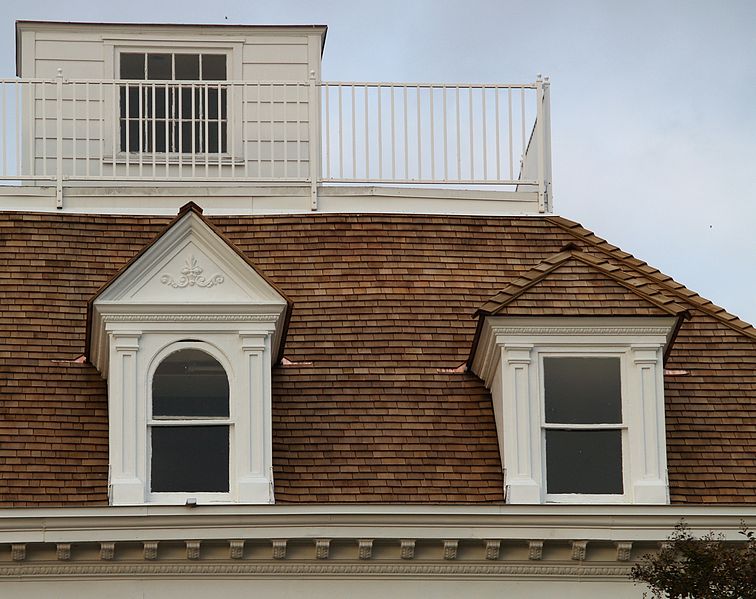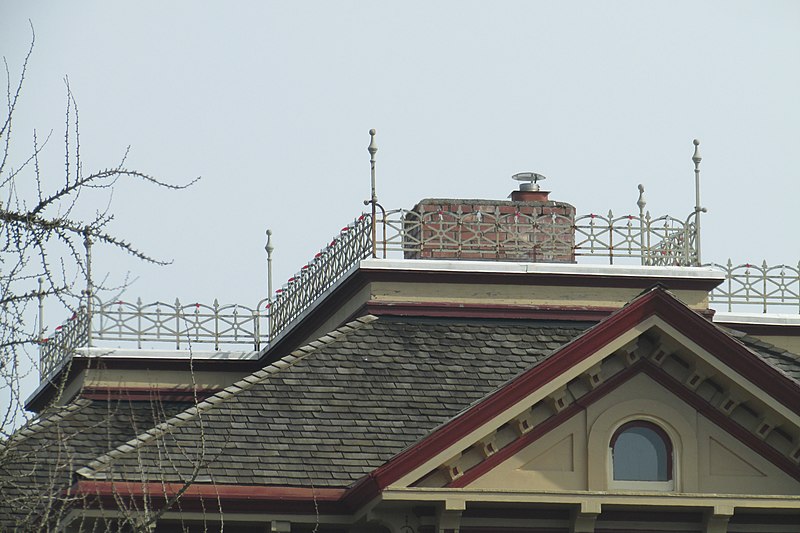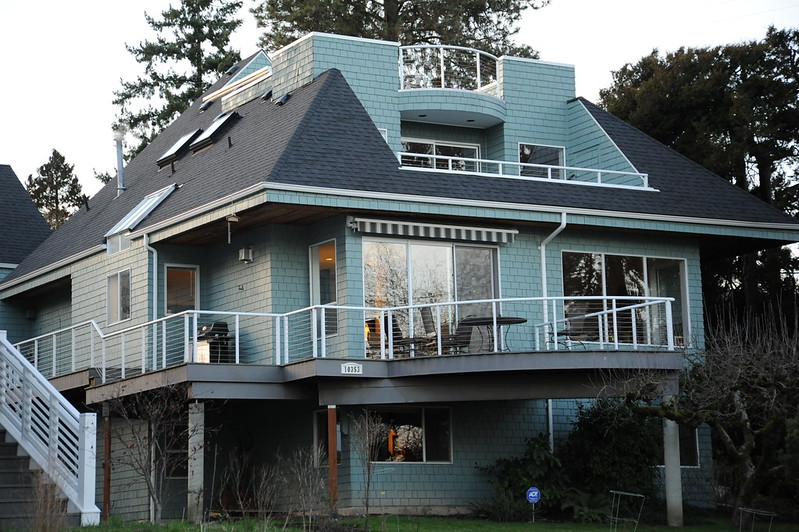Widow's walk

|
| Gabled dormer and hipped dormer below the widow's walk - Gaithersburg, Maryland. |
Contents |
[edit] Introduction
A widow’s walk is a residential North American architectural feature. It is also referred to as a widow’s watch, a roofwalk, a captain’s watch or a captain’s walk.
These raised, railed platforms were first constructed on top of houses in the 1800s. They were often found on homes built on the seacoast, but they can also be found on inland homes.
Widow’s walks were a variation of the decorative Italianate cupola. However, original widow’s walks included an internal stairwell so they could be accessed quickly and easily.
[edit] The purpose of a widow’s walk
The staircase leading to the widow’s walk is the feature that distinguishes it as something functional rather than as a purely decorative cupola. Original widow’s walks were often built around the chimney of the building, serving as a method of managing chimney fires.

|
| This widow's walk is on the Ezra Meeker Mansion, which was originally constructed between 1886 and 1890. Meeker was known as the 'Hop King of the World' and used his wealth to build this large home near the the Puyallup River estuary in Puyallup, Washington. |
Large barrels would be placed on the widow’s walk and filled with sand or water that could be used to extinguish fires. Empty pails would be left nearby on the widow’s walk, so they could be grabbed quickly during an emergency.
At the time, homes were primarily heated by wood burning fires and food was cooked in large, open fireplaces. Buckets of sand and water would be placed near the fireplaces for emergencies, but having additional buckets at the top of the chimney was considered an extra safety measure.
In colonial American times, widow’s walks were very simple. Lacking decorative features, these widow’s walks were purely practical. Some were nothing more than a hatch.
[edit] The legend of the widow’s walk
As prosperity came to America, people began to build more elaborate houses, and the widow’s walk - still necessary - became more ornate.
Then in the 19th century folklore grew around this functional structure. According to tales spun about widow's walks, dutiful wives were said to patrol these platforms and used them as a lookout while awaiting the safe return of their seafaring spouses.
Another piece of folklore claims the platforms - also referred to as a captain’s walk - were used by successful seafarers and important maritime merchants. It is said these prosperous ship owners, businessmen and captains would use the watches to search the horizon for ships due in port.
[edit] Modern benefits of widow's walks
While people certainly did use the widow’s (or captain’s) walks as lookout perches, that did not become their primary function until modern times. In the 20th century, shorefront development increased and so did land prices.
For those who couldn’t afford expensive waterfront properties, the only way to get a view of the water was to invest in affordable property located away from the shore. Property owners could then build their homes high enough to see over the properties in front of them. This is how the modern widow’s walk became popular.

|
| This contemporary house with a widow's walk is located in North Matthews Beach, Sand Point Way Uplands, Seattle, Washington. |
Modern widow’s walks can be completely open, although some have removable or retractable canopies that shield users from bad weather. Widow's walks can be used for entertaining purposes or as spaces for stargazing. It is also possible to enclose them in such a way as to create additional living space protected against insects, noise, smells and other undesirable circumstances.
[edit] Related articles on Designing Buildings Wiki
- American architecture and construction.
- Balcony.
- Belvedere.
- Conservatory.
- Cupola
- Deck
- Don’t Look Down! – Skyscraper window cleaning through the ages.
- Dormer window.
- Patio.
- Peel tower.
- Wrought iron porch.
[edit] External resources
- NPR, "Widow's Walk: Sailor's Friend, or Fire Station?" John Ciardi, 27 April 2006.
Featured articles and news
A change to adoptive architecture
Effects of global weather warming on architectural detailing, material choice and human interaction.
How big is the problem and what can we do to mitigate the effects?
Overheating guidance and tools for building designers
A number of cool guides to help with the heat.
The UK's Modern Industrial Strategy: A 10 year plan
Previous consultation criticism, current key elements and general support with some persisting reservations.
Building Safety Regulator reforms
New roles, new staff and a new fast track service pave the way for a single construction regulator.
Architectural Technologist CPDs and Communications
CIAT CPD… and how you can do it!
Cooling centres and cool spaces
Managing extreme heat in cities by directing the public to places for heat stress relief and water sources.
Winter gardens: A brief history and warm variations
Extending the season with glass in different forms and terms.
Restoring Great Yarmouth's Winter Gardens
Transforming one of the least sustainable constructions imaginable.
Construction Skills Mission Board launch sector drive
Newly formed government and industry collaboration set strategy for recruiting an additional 100,000 construction workers a year.
New Architects Code comes into effect in September 2025
ARB Architects Code of Conduct and Practice available with ongoing consultation regarding guidance.
Welsh Skills Body (Medr) launches ambitious plan
The new skills body brings together funding and regulation of tertiary education and research for the devolved nation.
Paul Gandy FCIOB announced as next CIOB President
Former Tilbury Douglas CEO takes helm.
UK Infrastructure: A 10 Year Strategy. In brief with reactions
With the National Infrastructure and Service Transformation Authority (NISTA).
Ebenezer Howard: inventor of the garden city. Book review.
Airtightness Topic Guide BSRIA TG 27/2025
Explaining the basics of airtightness, what it is, why it's important, when it's required and how it's carried out.






















